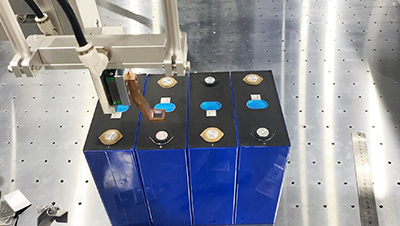Categories
New Blog
Introduction to power lithium-ion battery welding methods and processes
February 27 , 2024Introduction to power lithium-ion battery welding methods and processes
Fiber Laser welding machine uses the excellent directivity and high power density of the laser beam to work. The laser beam is focused on a small area through the optical system, forming a highly concentrated heat source in the welded area in a very short time. area, so that the object to be welded melts and forms a strong welding point and welding seam.
2. Laser Welding Type
Thermal Conduction Welding and Deep Penetration Welding
The laser power density is 105~106w/㎝² to form laser heat conduction welding, and the laser power density is 105~106w/㎝² to form laser deep penetration welding.
Penetration and Seam Welding
Penetration welding, the connecting piece does not need to be punched, and the processing is relatively simple. Penetration welding requires a more powerful laser welder. The penetration depth of penetration welding is lower than that of seam welding, and its reliability is relatively poor.
Compared with penetration welding, seam welding requires a smaller power laser welder. The penetration depth of seam welding is higher than that of penetration welding, and its reliability is relatively good. However, the connecting piece needs to be punched, which is relatively difficult to process.
Pulse Welding and Continuous Welding
1) Pulse mode welding
Appropriate welding waveforms should be selected during laser welding. Commonly used pulse waveforms include square waves, peak waves, double-peak waves, etc. The reflectivity of the aluminum alloy surface to light is too high. When a high-intensity laser beam hits the material surface, the metal surface will 60%-98% of laser energy is lost due to reflection, and the reflectivity changes with surface temperature. Generally, when welding aluminum alloys, it is best to choose pointed waves and double-peaked waves. The pulse width of the slow-down part behind this kind of welding waveform is longer, which can effectively reduce the occurrence of pores and cracks.
Pulse laser welding samples
Due to the high reflectivity of aluminum alloy to laser, in order to prevent the laser beam from being vertically incident and causing vertical reflection and damaging the laser focusing mirror, the welding head is usually deflected at a certain angle during the welding process. The diameter of the solder joint and the diameter of the effective joint surface increase with the increase of the laser tilt angle. When the laser tilt angle is 40°, the largest solder joint and effective joint surface are obtained. The welding spot penetration and effective penetration decrease with the laser tilt angle. When it is greater than 60, the effective welding penetration drops to zero. Therefore, by tilting the welding joint to a certain angle, the weld penetration depth and width can be appropriately increased.
In addition, during welding, with the weld seam as the boundary, 65% of the laser welding spot partial cover plate and 35% of the shell need to be welded, which can effectively reduce explosions caused by cover closing problems.
2) Continuous mode welding
Because the heating process of continuous laser welding is not like the sudden cooling and heating of pulse machines, the tendency of cracks during welding is not very obvious. In order to improve the quality of the weld, continuous laser welding is used. The surface of the weld is smooth and uniform, with no spatter, no defects, and no defects inside the weld. No cracks found. In the welding of aluminum alloys, the advantages of continuous laser are obvious. Compared with traditional welding methods, the production efficiency is high and no wire filling is required. Compared with pulse laser welding, it can solve the defects that occur after welding, such as cracks, Porosity, spatter, etc. ensure that the aluminum alloy has good mechanical properties after welding; there will be no dents after welding, and the amount of polishing and polishing after welding is reduced, which saves production costs. However, because the spot of the continuous laser is relatively small, the assembly accuracy of the workpiece is not The requirements are higher.
3. Advantages of Laser Welding
4. Difficulties In Laser Welding Process

5. Factors Affecting Welding Quality
Laser welding is currently an important method recommended for high-end battery welding. Laser welding is a process in which a high-energy beam of laser irradiates the workpiece, causing the working temperature to rise sharply, melting the workpiece and reconnecting to form a permanent connection. The shear strength and tear resistance of laser welding are relatively good. The conductivity, strength, air tightness, metal fatigue and corrosion resistance of battery welding are typical welding quality evaluation criteria.
There are many factors that affect the quality of laser welding. Some of them are extremely volatile and have considerable instability. How to correctly set and control these parameters so that they are controlled within an appropriate range during high-speed and continuous laser welding to ensure welding quality. The reliability and stability of welding seam formation are important issues related to the practicality and industrialization of laser welding technology. The important factors affecting the quality of laser welding are divided into three aspects: welding equipment, workpiece condition and process parameters.
Acey new energy is a professional supplier specialized in Lithium Battery Pack Assembly Machine, such as battery capacity grading machine, battery insalution paper sticking machine, battery sorting machine, BMS tester, battery spot welding machine, laser welding machine, ultrasonic wire bonding machine, battery comprehensive tester, battery pack charge and discharge aging tester, etc and we provide one-stop solution for battery pack assembly line. If any interested, please feel free to contact us.